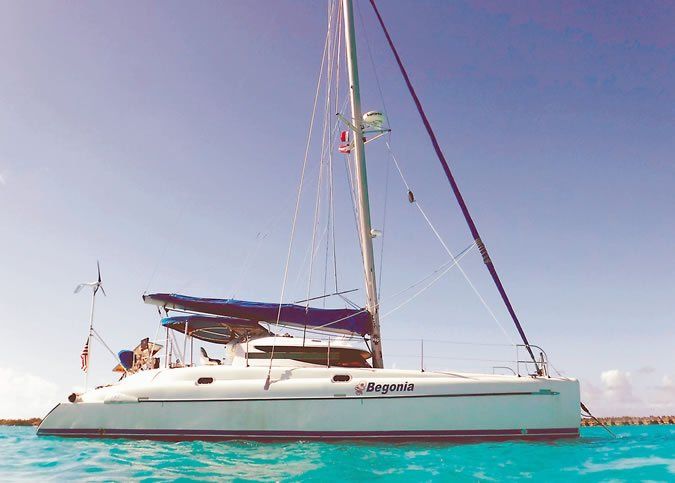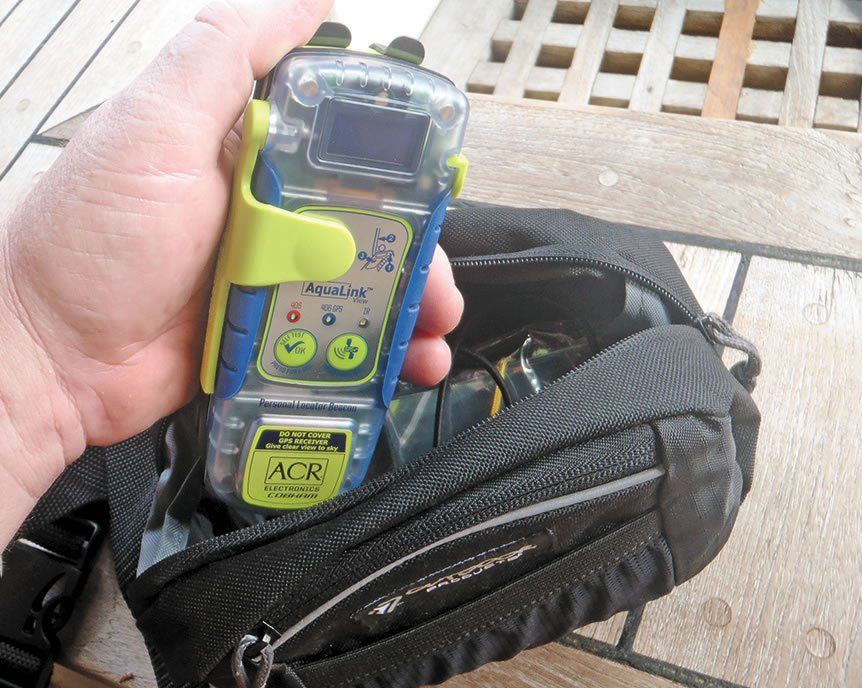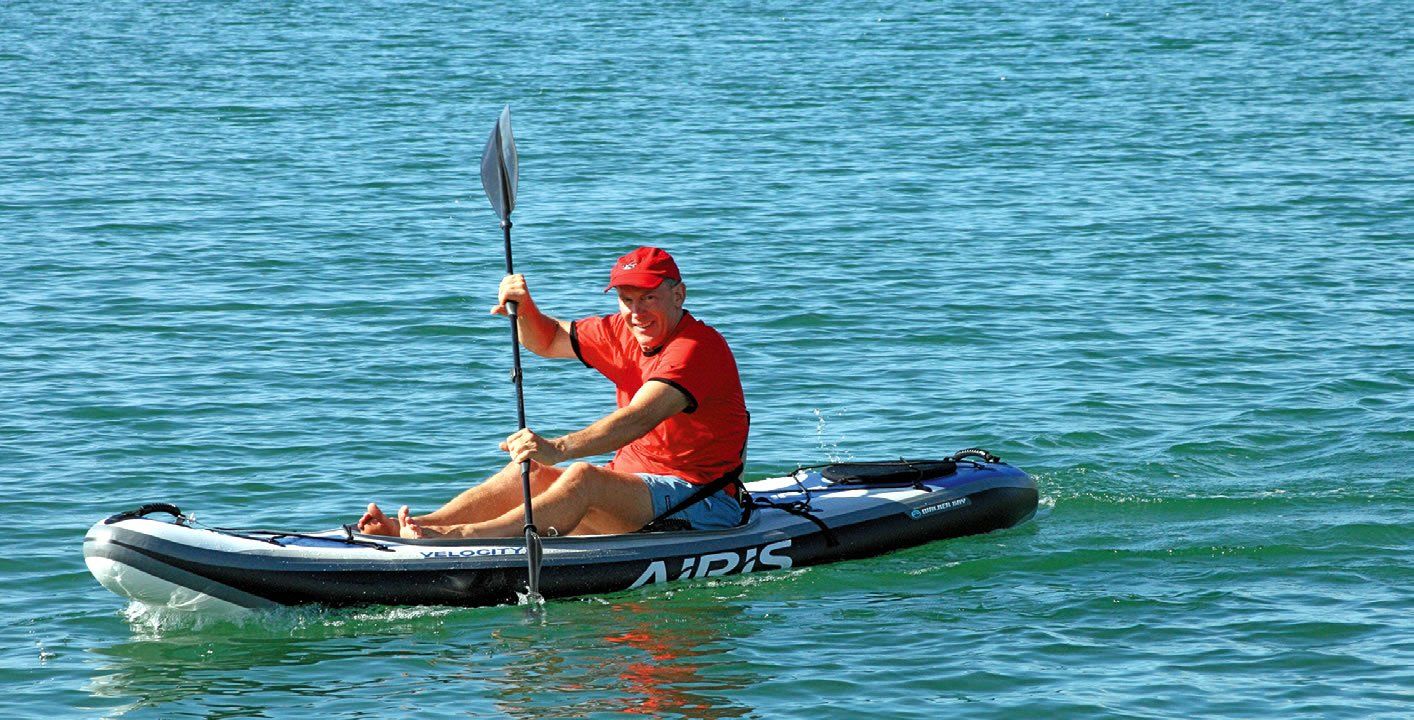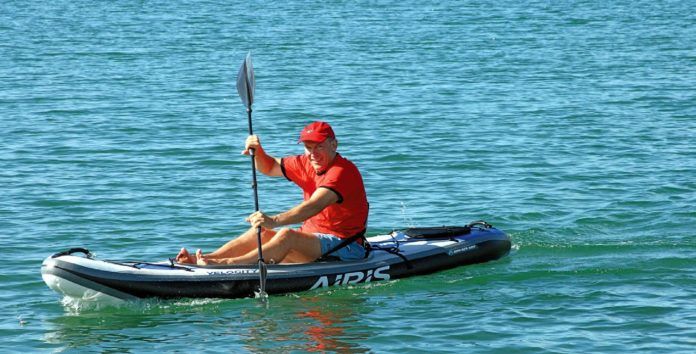
Photo courtesy of Kim Sharpe
EPIRB Battery Shocker
We have an ACR Global Fix EPIRB and an ACR Aqualink PLB. We had the EPIRB battery replaced 5 years ago in the USA, and it is time again to do so. We are currently in New Zealand and have been given a quote of close to $350 to replace the EPIRB battery and $120 for the PLB.
It is less expensive to simply buy a new EPIRB, and this has the added bonus of giving us a 10-year battery life (saving another battery change).
Obviously, all safety equipment needs to be up to date to give us confidence in it – but the price of looking after this is simply crazy. Self-service is not possible. I wish we had understood this before we left the U.S., and also up front when we made our purchase decision.
I contacted the ACR dealer directly in New Zealand. They were very helpful, and warned us against buying an EPIRB in most boat stores in NZ (and I assume any other country aside from the USA) as you may not be able to register them in the U.S. without some reprogramming if at all. Additionally they tell me our ACR EPIRB is only good for two battery changes.
This makes these very expensive items practically disposable, and we are very disappointed and shocked. I thought you might like to know about any future reviews you do on EPIRBs and PLBs, something to add is the cost/frequency and (limited) repeats for battery changes and how internationally supported such services are.
Maryanne & Kyle Webb
SV Begonia, Fontain Pajot Athena
Portland, Or.

The seemingly planned obsolescence of distress alerting devices has long been our concern, as the editor describes in his blog post, Gear Graveyard: Expired EPIRB Batteries, Obsolete EPIRBs on Inside Practical Sailor (www.practical-sailor.com). The New Zealand dealer was correct that buying a new EPIRB outside of your home country requires special cooperation from the manufacturer and registering agencies and is probably best avoided, if possible. The EPIRBs unique code includes the country of origin, and this can play a role in how a rescue is handled. Having a U.S.-registered vessel with a New Zealand number can lead to confusion that might delay a search. Weve reported on the case of the Beneteau 44 Sean Seymour in which rescue was been delayed because of some difficulty managing registration data (PS December 2009). You don’t mention a third challenge, that flying home and back with a replacement unit can involve skirting the airline rules on lithium batteries-which need to be removed and carried in hand luggage. We always try to include battery replacement costs in our product tests and to remind readers that, like life raft inspections, battery replacement is a big hidden cost in these devices.
Crotch Straps Save Lives
I just saw your recent post about crotch straps on personal flotation devices (see PS Advisor, April 2007). I spent last summer singlehanding my Pacific Seacraft Crealock 34, Serenity, on a loop across Lake Ontario, through the Trent-Severn, straight across Georgian Bay (in heavy weather for the second half of that 120 miles), summered in the North Channel, then down Lake Huron (through another storm for part), then Lakes St. Clair, Erie and finally Ontario to return home.
I wore a Spinlock Deckvest 5D religiously, and stayed clipped on to padeyes or a Wichard jackline system set inboard. I was well aware that if I fell overboard I was dead. The Spinlock has dual crotch straps, and for me they were no major problem, and Im not sure I even noticed them being there comfort-wise even though I snugged then reasonably tight. The peace of mind knowing the flotation was going to stay where it belonged should I find myself floating was worth it.
I can’t speak about other harness/PFD combinations, but the Spinlock was quite comfortable.
Brian Laux
Serenity, Pacific Seacraft 34
Ontario, CA
Practical Sailor strongly recommends crotch straps in harness/lifejackets (PFDs) and these are required under World Sailing rules for offshore racing. Crotch straps have been proven to offer three important advantages: keeping the wearer afloat with less effort, keeping an inflatable lifejacket on in rough water or surf, and keeping the wearer in the harness during recovery. Although our own testing found that a snugly fitted PFD/harness without a crotch strap can serve as a lifting harness during recovery, many older devices are not designed or tested for that purpose. Some newer models, like those used in the Clipper Around the World race have a designated attachment point for lifting. If you are going to use the tether for lifting a victim, it is something you will want to try first to see if it is practical. Some body types, especially large individuals, absolutely require a crotch strap. Weve found that most users do not wear their harness/PFDs too loosely, and the crotch strap helps compensate for that.
Documentation Scams
The Coast Guard has in the past sent out notifications of impending documentation expiration with a request to confirm ownership of a particular vessel. Once this information was received, a new documentation certificate was mailed out. This year, owners are required to apply for a renewal of documentation from the U.S. Coast Guard. This can be done online for $26. Some private organizations which provide documentation services have mailed out courtesy notifications to some owners offering to handle this process for a fee. In some cases, according to the October issue of SpinSheet Magazine, these fees could be as much as $350. The USCG has issued warnings about such non-USCG communications.
I received a letter from The Marine Documentation Center offering these services. These letters may look similar to USCG written communications, however these are non USCG organizations! It is easy to access the NVDC (National Vessel Documentation Center) on the USCG website. Go to USCG Home- NVDC- Renew-Forms-Secure-Payment Site. Ittakes about 10 minutes.
Lenny Lipscomb
Miss Liberty, Beneteau 473
Deltaville, Va
Photo courtesy of Mahina Expeditions (Mhainatiare.com)

Folding Kayaks
Regarding your recent report Kayaks for Cruisers, (see PS November 2017): Kayak enthusiasts have long admired the 17-foot durable folding kayaks made by Klepper and Folboat. Properly fitted out with foot rudders, long double paddles and protective skirts these are true blue water kayaks capable of crossing oceans. With impressive stability and turn of speed, they are a real step above the calm water plastic kayaks discussed. Kleppers are passed down from one generation to the next !
Peter I Berman
Norwalk, CT
Upside Down Paddle
In your recent report on kayaks, you had an article on effective paddling, except in the accompanying photo the paddler is holding the paddle upside-down! He needs to switch the paddle blades to the opposite sides, so you can read the name right-side up. Held as in the photo, he will have little power in his stroke, especially if the blades are feathered, which they should be. Inmany years of ocean kayaking, including kayak surfing competition, I never met an experienced paddler who preferred unfeathered blades. As you say, a good paddle is necessary to having fun in a kayak.
Scott Eaton
Moonraker, Beneteau First 32s5
Dana Point, CA
Oops. The editor responsible for selecting the photo has been re-assigned to bottom painting duty for the rest of the week. The choice of images should in no way reflective of the testers long experience with kayaks and paddles.
Watchkeeping
A recent PS Advisor on watchkeeping (see PS November 2017), asked for readers to share their sleep routines at sea. My wife, a friend, and I sailed across the Pacific from Cabo San Lucas to Nuku Hiva, 23-1/2 days. We used the standard four-hour watch schedule for the three of us, giving each person eight hours of sleep.
When we sailed from Rarotonga, Cook Islands, to Niue, then to Vavau, Tonga, then on to Viti Levu, Fiji, with only two crew, we began using a 5-4-3 schedule. When its only the two people on board, thats what we use.
The 5-4-3 schedule does not vary, so one gets used to the times. We both have 5-hour watches during the day when were both awake, 4-hour watches in the evening as we slow a bit, and 3-hour watches in the early morning when were both a bit bleary and need to be at peak performance. Im the morning person, so I take the second 3-hour watch, and that dictates the rest of the schedule. The comment about scheduling around ones strengths is valid.
Here are the time segments for each watch in the schedule: 0000-0300; 0300-0600; 0600-1100; 1100-1600; 1600 -2000; 2000-2400. Weve sailed a lot of miles with this system, so it is something to consider for couple. A five-hour sleep is more to my liking, especially as I get older.
Bill Ennis
Wings, 1984 Passport 40
Anchorage, AK
Thanks to all the readers who continue to supplement this report online with their experiences. The importance of a healthy, well-rested crew- especially when foul weather or a landfall approaches-cannot be understated.
CLARIFICATION
In the December 2017 product update on joker valves, Marine Toilet Tech: New Joker Valve, we failed to reference the latest results of ongoing testing. The article stated that when we last compared joker valves for marine heads (see Joker Valves for Marine Heads, PS July 2013), Jabscos Xylem Flow tricuspid valve stood out in the field. However, our ongoing testing has led us to modify those initial findings. After several rounds of subsequent long-term testing in the field and lab, Raritans PHII joker valve is performing far better than its competitors. The Raritan valve requires slightly greater pumping force, but weve not had any clogs. The Raritan valves seems to last nearly twice as long as other joker valves before allowing backflow.
Joker valve failure is almost always due to scale build-up, but the stiffer designs such as the Raritan, seem to endure scale buildup better. The Raritan PHII valve is conveniently interchangeable in Jabsco and Groco manual heads and will remain our recommendation until we have enough field test time to be certain.

Vanderbilt University is offering a free online course in celestial navigation fundamentals. The coursedeveloped in collaboration with PS Technical Editor Ralph Naranjo, covers the basics for completing a sight reduction form to obtain a line of position (LOP).
Those wishing to further their celestial navigation skills can also take a course taught by Naranjo, author of “The Art of Seamanship,” at the Annapolis School of Seamanship. The next course two-day course is February 24. Ralph also teaches two courses on weather for sailors. For course dates and details, visit www.annapolisschoolofseamanship.com.



































